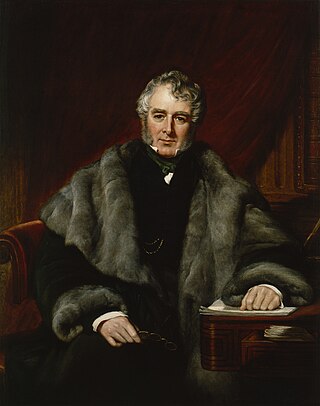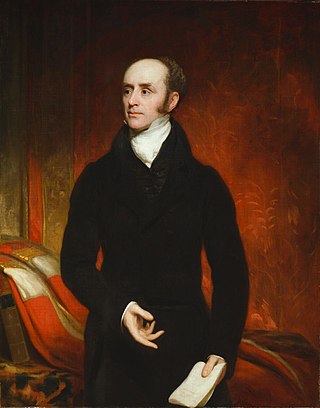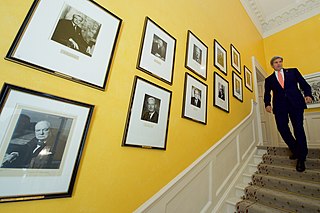
The 1830s was a decade of the Gregorian calendar that began on January 1, 1830, and ended on December 31, 1839.

1834 (MDCCCXXXIV) was a common year starting on Wednesday of the Gregorian calendar and a common year starting on Monday of the Julian calendar, the 1834th year of the Common Era (CE) and Anno Domini (AD) designations, the 834th year of the 2nd millennium, the 34th year of the 19th century, and the 5th year of the 1830s decade. As of the start of 1834, the Gregorian calendar was 12 days ahead of the Julian calendar, which remained in localized use until 1923.

William Lamb, 2nd Viscount Melbourne, in some sources called Henry William Lamb, was a Whig politician who served as the Home Secretary and twice as the Prime Minister of the United Kingdom.

Sir Robert Peel, 2nd Baronet,, was a British Conservative statesman who served twice as Prime Minister of the United Kingdom, simultaneously serving as Chancellor of the Exchequer (1834–1835), and twice as Home Secretary. He is regarded as the father of modern British policing, owing to his founding of the Metropolitan Police Service. Peel was one of the founders of the modern Conservative Party.

John Russell, 1st Earl Russell,, known by his courtesy title Lord John Russell before 1861, was a British Whig and Liberal statesman who served as Prime Minister of the United Kingdom from 1846 to 1852 and again from 1865 to 1866.

Charles Grey, 2nd Earl Grey, known as Viscount Howick between 1806 and 1807, was a British Whig politician who served as Prime Minister of the United Kingdom from 1830 to 1834. He was a descendant of the House of Grey and the namesake of Earl Grey tea. Grey was a long-time leader of multiple reform movements. During his time as prime minister, his government brought about two notable reforms. The Reform Act 1832 enacted parliamentary reform, greatly increasing the electorate of the House of Commons.

Robert Banks Jenkinson, 2nd Earl of Liverpool, was a British Tory statesman who served as Prime Minister of the United Kingdom from 1812 to 1827. He also held many other important cabinet offices such as Foreign Secretary, Home Secretary and Secretary of State for War and the Colonies. He was also a member of the House of Lords and served as leader.
The year 1834 in science and technology involved some significant events, listed below.

The article lists the records of prime ministers of the United Kingdom since 1721.

The Tithe War was a campaign of mainly nonviolent civil disobedience, punctuated by sporadic violent episodes, in Ireland between 1830 and 1836 in reaction to the enforcement of tithes on the Roman Catholic majority for the upkeep of the established state church, the Church of Ireland. Tithes were payable in cash or kind and payment was compulsory, irrespective of an individual's religious adherence.
Events from the year 1828 in the United Kingdom.
Events from the year 1830 in the United Kingdom. This year sees a change of monarch.
Events from the year 1835 in the United Kingdom.
Events from the year 1836 in the United Kingdom.
Events from the year 1812 in the United Kingdom. The United Kingdom is still involved in the Napoleonic Wars with France and its attempts to stop French trade lead to the War of 1812 with the United States. Lord Wellington is active in the Peninsular War in Spain. This year also marks the only assassination of a British prime minister when Spencer Perceval is shot.
Events from the year 1822 in the United Kingdom.
Events from the year 1846 in the United Kingdom. This year is noted for the repeal of the Corn Laws.
Events from the year 1841 in the United Kingdom.
Events from the year 1843 in the United Kingdom.
Events from the year 1834 in Ireland.









